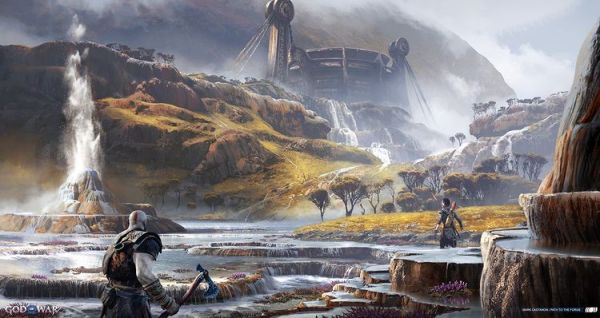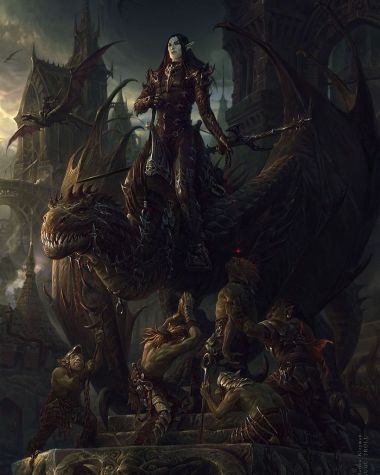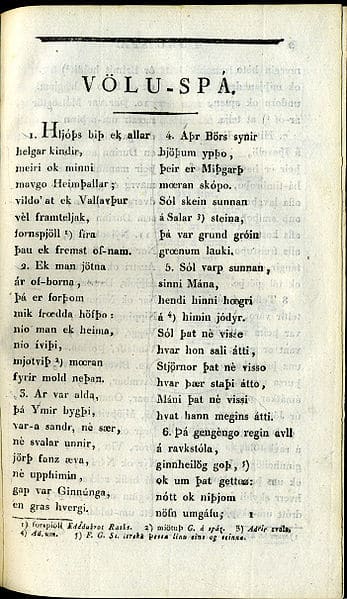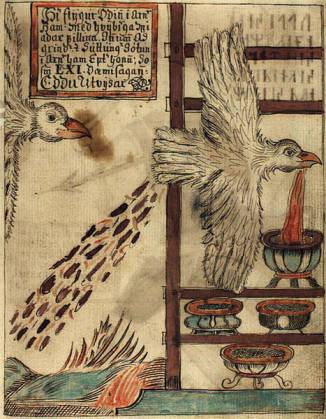In Norse mythology there is traditionally said to be nine realms, all interconnected and held in place by the cosmic tree Yggdrasil. Among these realms, Svartalfheim (Old Norse Svartálfheimr) is known as the realm of the Dark Elves (Old Norse Dökkálfar/Dvergr) . They are popularly thought of as the “opposite”, or dark/swarthy cousins of the Light Elves, (Ljosálfar).
From various mentions in both trusted sources for Old Norse myths, and some less so, we know that the realm is found hidden underground. It is here, in great caverns and underground halls that the dwarves have made their home.
However, as is often the case with our understanding of Norse mythology, what we really know for sure is less clear. In this post I am trying to pull together what we can say for certain, while also pointing out some things I believe are misconceptions.
What’s in a name – Svartalfheim or Nidavellir
The Old Norse Svartálfheimr translates as “Black Elves Home/Realm”, as the -heimr ending refers to a realm for certain beings. This is much the same as with Álfheimr, home to the Light Elves, Jotunheimr, home to the jötnar, and Vanaheimr, home to the Vanir gods.
The name Svartalfheim is only found used by Snorri Sturluson in his Prose Edda. Because of this, the possibility of Snorri inventing the name has been raised. However, that the realm of the dwarves (or Dark Elves as Snorri calls them) is below ground is fairly well established.
In another source, from the more reliable Poetic Edda collection of poems, another name is used for the realm of the dwarves. Found in stanza 41 of the Völuspá poem, the volva tells Odin where the race of Sindri lives. Sindri being one of a pair of dwarf brothers, Brokkr being the other, who take part in another well known story.
41. On the north there stood, on Nida-fells, a hall of gold, for Sindri’s race; and another stood in Okôlnir, the Jötuns beer-hall which Brîmir hight.
In the original Old Norse “Nida-fells”, is written as Niðavöllom, also called Niðvellir, meaning “fields below”. The Old Norse niðr, meaning down/below, and -völlum, or -vellir meaning fields.
Nidavellir is not the same as Myrkheimr
When researching this post, I have come across a couple of places stating that another name for Svartalfheim/Nidavellir is Myrkheimr, roughly translated as “The dark realm”. This is not based on any actual mention anywhere that the dwarves live in Myrkheimr, or that their realm is called that.
The only instance I found from the Poetic Edda poems is in Atlakvitha. Late in the poem, there is a line about Myrkheimr, however that is in reference to someone dead, or soon to be dead, going or coming from there. So, while that place is also dark, and seemingly underground, it is a name for a place for the dead, not for dwarves.
The Geography of Svartalfheim
Interestingly though, the realm of the dwarves seems to be close to Helheim, the realm of the dead. The direction to Helheim is said to be located “to the north and down”, much like the path to Svartalfheim.

There is another parallel to the realm of the dead as the dvergr/dwarves could seemingly use any stone or mountain as an entryway to their underground realm. In the same way, the vikings believed that treasure (or anything really) buried underground or in a bog, would be accessible to them in the afterlife. So both the realm of the dead, and that of the dwarves was below Midgard, as situated in the cosmic tree Yggdrasil.
From what little you can glean from mentions of the dwarves or their realm, Svartalfheim is envisioned as a realm of deep, dark caverns and endless mines. There, the light seldom reaches and the landscape is as rugged as it is enigmatic. This underground world is rich in minerals and precious gems, reflecting the Dark Elves’ affinity for smithing and crafting.
Notable features within Svartalfheim include the great forges where legendary artifacts were created, such as the gods’ weapons and treasures. These sites are not just places of work but sacred spaces where magic and craftsmanship intertwine. The results giving birth to items of immense power and beauty.
It’s worth remembering that the dwarves were not only master craftsmen, but they often used magic when crafting special items. Creating enchanted or magical artifacts like Odin’s spear Gungnir, Thor’s mighty hammer Mjolnir and Freyr’s boar Gullinbursti, to mention but a few.
Inhabitants of Svartalfheim: The Dark Elves

The dwarves, or Dark Elves, of Svartalfheim, hold a unique place in Norse mythology, emerging from the primordial essence of the cosmos rather than being born in a conventional sense. According to the myths, they emerged from the decaying flesh of Ymir as maggots, after the gods used his body to craft the world. This origin story paints the dwarves as entities as ancient as the earth itself, born from a cycle of life, death, and regeneration. Moreover, they are connected to the earth, and the underground realm.
Nature and Abilities of the Dwarves
While often cast in a less favorable light, the dwarves aren’t enemies of the gods like the jotnar are. Instead they are seemingly held in high regard for their craftsmanship and in several cases, come to the aid of the gods when they need something especially well crafted.
However, they are also known, according to the myths, as a race who are cunning, crafty and wily. As such, the gods are not above robbing them, or tricking them if they can. In Alvissmál, a dwarf named Alviss shows up on Thor’s door to collect Thor’s daughter Thrud to be his wife (promised him in a lost poem). Thor then mocks him for looking blue and pale, inquiring if he has slept with a corps. In the end, Thor tricks Alviss to be outside so long that the sun rises, turning the dwarf into stone as it does.
This aspect of them being vulnerable to sunlight is seemingly not always the case, and is also said to (sometimes) be the case for jotnar. This shows how fluid Old Norse mythology is and how things aren’t always consistent across poems.
Physically, dwarves are often depicted as short, stocky beings, embodying their connection to the earth. However, I’m sure this should be taken as literally as we do today. This is the same as how jotnar are called giants. Yet some jötuns are in fact the same size as the gods, like Skadi who marries Njord, or Gerdr who marries Freyr. Depending on the story, the size of both gods, jotnar and dwarves might be somewhat flexible.
Shapeshifting Dwarves
In some instances, the dwarves are also said to be able to shapeshift, taking the form of animals. The rich dwarf Andvari takes the form of a salmon when Loki goes to catch him. And later in the same story, the dwarf Fafnir, turns into a dragon in order to protect his gold treasure.
Svartalfheim and Nidavellir in the Eddas
As I mentioned earlier, there is possibly good reason to think that the name Svartalfheim is an invention by Snorri, rather than a name vikings actually used. This is because the only two instances where the name is used, is in fact found in Snorri’s Prose Edda.
In Gylfaginning, chapter nine, we find a reference to Svartalfheim being the realm of the Dark Elves.
So Alfather sent the youth, who is called Skirner, and is Freyr’s messenger, to some dwarfs in Svartalfaheim, and had them make the fetter which is called Gleipner. It was made of six things: of the footfall of cats, of the beard of woman, of the roots of the mountain, of the sinews of the bear, of the breath of the fish, and of the spittle of the birds.
This also highlights how the dwarves used magic as well as craftsmanship when creating some of their most renowned items.
In Skaldskaparmál, chapter thirtynine, Svartalfheim is also mentioned. In the English translation I have shared (see below), it is translated to “Land of the Black Elves”. However, in the original it is Svartálfheimr.
Then the otter was flayed, and Hreidmarr, taking the otter-skin, asked them to fill the skin with red gold and also cover it altogether; and that should be the condition of the covenant between them. Then Odin sent Loki into the Land of the Black Elves, and he came to the dwarf who is called Andvari, who was as a fish in the water.
These are the two only mentions of Svartalfheim as the name for the realm of the Dark Elves in Old Norse texts. This is notable since Snorri has been found to take some great creative liberties in his work. Sometimes by choice, and seemingly sometimes by ignorance or misunderstanding.
Nidavellir in the Völuspá

The name Nidavellir, or in Old Norse Niðavellir is also not mentioned especially often. It is actually only found in the Poetic Edda poem Völuspá. The poem has been found in a few of the ancient manuscripts containing the collection of poems known as the Poetic Edda. While written in the 13th century, the actual poems are believed to come from the 8th or 9th century.
In stanza 37 of the Völuspá, the first half of the verse reads:
Stóð fyr norðan
á Niðavöllum
salr ór gulli
Sindra ættar;
In this verse, Niðavöllum is just another way of writing Niðavellir, as -völlum and vellir both means fields.
Stood to the north
at Nidavellir
halls of gold
for Sindri’s kin
Based on this slim finding, there is ample reason to believe that if the vikings indeed used either name for the realm of the Dark Elves/Dwarves, it would have been Nidavellir. It is an actual name, for the realm of the dwarves, used in a contemporary poem.
Key Myths and Legends Involving Svartalfheim
Throughout the Prose- and Poetic Edda, there are numerous tales of the dwarves. Often their home or realm is referred to, directly or indirectly.
The Gifts of the Gods: A Tale of Craftsmanship and Deception
Maybe the most interesting story is the one called “Gifts of the Gods” found in Heimskringla in the Prose Edda. The story starts off with Loki, being playful or just a pest, cuts off all of Sif’s beautiful golden hair.
Upon learning of this, Thor threatens him with bodily harm or worse, unless he can fix it. Not wanting to have “all his bones in his body crushed”, Loki turns to the master craftsmen, the dwarves. Upon returning with Sif’s new hair made from the finest gold threads and some other gifts, he boasts about the quality, and makes a wager for his head with a pair or dwarf brothers about the quality of items they could create.
In the end, Loki loses the bet, but manages to keep his head. In the story though, we are taken down into the deep of the underground realm. There we get a feel of the underground forges and what it’s like.
The Quest for the Mead of Poetry

Another noteworthy story is that of poor Kvasir and the “Mead of Poetry”. This story is set right after the Aesir-Vanir war, and the truce the gods made. In that process, all the gods spat into a vat, and from their saliva, they created, or a being magically came into being. That being, seemingly looking like a human, was named Kvasir.
Due to his unique creation, Kvasir was blessed with unlimited knowledge, and being an especially gifted poet of unrivaled eloquence. He would travel the lands, sharing his wisdom and poetry. Then one day met the two dwarf brothers Fjalar and Galar.
Being especially cunning and wily, and maybe with a special insight into the possibilities Kvasir held, they killed him. Then they made a special mead from his blood. The mead, made from his blood and honey, came to be known as “The Mead of Poetry”. Anyone who took the smallest sip, would gain immeasurable wisdom and poetic skills.
After having been made by the dwarves, they were killed for it by a jötun named Suttung. He in turn lost it to Odin. On his way to securing the mead in Asgard, a few drops of it found its way to Midgard. There, any people touched by it become famously skilled poets.
The Story of Álvíss and Thrud
Finally, another story involving a dwarf and their realm is the poem called Álvissmál, or the lay of Alviss. It is found in the Poetic Edda.
This poem is a funny and fairly short poem about a dwarf named Alviss. He one day turns up on Thor’s door asking, or rather demanding, the hand of Thor’s daughter Thrud in marriage. Interestingly, there is a backstory, which Alviss refers to, in which he does something, or creates something. For that service, he was promised Thrud as a bride, byt clearly not by Thor.
There are many clues like this in the old Poetic Edda poems to other poems that sadly have been lost. Most of the poems from the Viking Age were actually only written down one or even two hundred years after it ended, stories have been lost. Other stories might have been written down, but the books burned in a purge by the Christians against the pagans and their beliefs.
In the story, Thor tricks Alviss into a battle of wits which sees the poor dwarf caught out in sunlight. The sunlight turns the dwarf into stone. This is another interesting fact that seems to hold true sometimes, but not always. Furthermore, it might also affect jotnar, but again not always.
FAQs
Svartalfheim is one of the Nine Worlds in Norse mythology, known as the home of the Dark Elves or Dökkálfar.
The Dark Elves are mythical beings renowned for their craftsmanship and magical abilities, inhabiting the realm of Svartalfheim.
Svartalfheim is depicted as a dark, subterranean world, rich in minerals and the site of the Dark Elves’ great forges.
The Dark Elves play a crucial role as craftsmen and magic-users, influencing various myths and legends with their creations.
Final Thoughts
Svartalfheim, the realm of the Dark Elves, is less certain as a name than the actual existence of a realm for the dwarves or Dark Elves. Personally I am leaning towards it being a result of Snorri’s poetic liberties. Moreover I think that Nidavellir was more likely the name used in the Viking Age.
It was no doubt a place imbued with magic as well as craftsmanship. Placed geographically and spiritually somewhere between Midgard and Helheim/Niflheim.
Featured Image Credit: mark_castanon on Instagram
